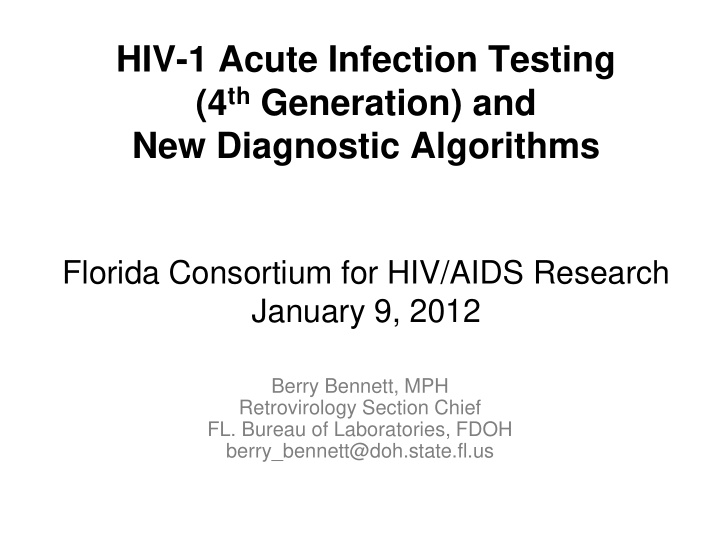



HIV-1 Acute Infection Testing (4 th Generation) and New Diagnostic Algorithms Florida Consortium for HIV/AIDS Research January 9, 2012 Berry Bennett, MPH Retrovirology Section Chief FL. Bureau of Laboratories, FDOH berry_bennett@doh.state.fl.us
Common HIV-1 or HIV-1/2 Diagnostic Algorithm
1989……………………….
Common HIV-1 or HIV-1/2 POC Rapid Test Algorithm
Challenges with the 1989 & 1998 Diagnostic Algorithms • Antibody tests do not detect infection in ~10% of infected persons at highest risk of transmission 1,2 • Western blot confirmation is less sensitive during early infection than many widely used screening tests • Assays were FDA approved as screening or supplemental tests in the confirmatory process, not as part of “multi -test algorithm”. • WB and IFA supplemental assays cannot differentiate HIV- 1 from HIV-2 infections. 1) Patel, et.al. Arch Intern Med 2010; 170:66-74 2) Stekler et.al. Clin Infect Diseases 2009; 49:444-53
Detection of HIV by Diagnostic Tests Symptoms p24 Antigen HIV RNA HIV EIA* Western blot 0 1 2 3 4 5 6 7 8 9 10 Weeks Since Infection * 4 th generation, Ag/Ab Combo EIA *3 rd generation, IgM-sensitive EIA * 2 nd generation EIA * viral lysate EIA Modified from After Fiebig et al, AIDS 2003; 17(13):1871-9
Characteristics & Performance of 4 th Generation Immunoassays • Simultaneous qualitative detection of HIV-1 p24 antigen and antibodies to HIV-1 (Groups M and O) and HIV-2 in human serum or plasma. • Abbott Architect HIV Ag/Ab Combo chemiluminescent assay (CIA), June 2010. PI sensitivity 100% (w/95% CI of 94.31 - 100%). PI specificity 99.77% (w/95% CI of 99.62 – 99.88%) • BioRad HIV Combo Ag/Ab EIA, July 2011. PI sensitivity 100% (w/95% CI of 99.7 – 100%). PI specificity 99.87% (w/95% CI of 99.76 – 99.93%).
Process for Developing New HIV Testing Algorithms for the U.S. APHL/CDC HIV Steering Committee (2006) Algorithm Workgroups [Point of contact (POC) and Laboratory] Goal = Develop multiple acceptable HIV testing algorithms, i.e., a menu of options APHL & NASTAD Public Health Surveys 2007 HIV Diagnostics Conference (December 5-7, Atlanta) Preparation of the Status Report, released April 2009 at www.aphl.org/hiv/statusreport Status Report promotion at national conferences 2010 HIV Diagnostics Conference ( March 24-26, Orlando) Release of the CLSI Guidelines 1 , July 2011 CDC Dear Colleague letter to Surveillance Cordinators, Nov. 18, 2011 Each state must examine their case reporting and Ryan White eligibility criteria Ongoing data gathering: retrospective and prospective CDC Interim Guidance anticipated by mid-2012 2012 HIV Diagnostic Conference set for Dec. 12-14, 2012 Final CDC Recommendations to follow 1 Criteria for Laboratory Testing and Diagnosis of Human Immunodeficiency Virus Infection: Approved Guidelines. Clinical and Laboratory Standards Institute, M53-A.
CDC Dear Colleague Letter to Surveillance Coordinators – Nov. 18, 2011 “Supplemental HIV antibody tests” need not be limited to Western Blot or IFA. Other antibody tests are acceptable as supplemental tests, including some that might alternatively be used as initial screening tests, provided that the screening and supplemental tests are used together as parts of an algorithm.
Characteristics of the Proposed HIV Diagnostic Algorithm • Detect acute as well as established HIV infections • Differentiate HIV-1 from HIV-2 • Get timely results to facilitate initiation of care - more same day reporting • Eliminate indeterminate and inconclusive results whenever possible
Proposed Laboratory Algorithm
Possible HIV-1/HIV-2 Differentiation Immunoassays Recombinant HIV-1 gp41 Serum Control 1 gp36 2 gp160 Peptide HIV-1 gp41 3 gp120 Peptide HIV-2 gp36 4 gp41 5 gp24
Proposed HIV Point of Care Algorithm 2 Two Rapid Tests (A1/A2) Performed in Sequence on Blood or Oral Fluid (A1 and A2 must be different rapid tests) A1 [HIV-1 or HIV-1/2 rapid test (Blood or oral fluid)] A1+ A1- Negative for HIV-1 and HIV-2 antibodies * A2 [HIV-1 or HIV 1/2 rapid test from a different manufacturer ( blood)] A1+ A2- A1+ A2+ Inconclusive rapid test Presumptive positive for result; HIV-1 or HIV-2 requires additional testing antibodies; requires medical follow-up for further evaluation and testing *If using an HIV-1 only rapid test, Negative for HIV-1 antibodies only
Alternative Algorithms • Individual or pooled NAAT on seronegative specimens (primarily reflex testing) • Traditional algorithm with supplemental NAAT option • Algorithms for oral fluid and dried fluid spot (DFS) specimens • “Bridge algorithms” (POC – laboratory – clinical management)
HIV Testing Algorithm Information • HIV Testing Algorithms: A Status Report (5/2009) http://www.aphl.org/hiv/statusreport • 2010 HIV Diagnostics Conference: http://www.hivtestingconference.org • CLSI M53-A, Criteria for Laboratory Testing and Diagnosis of HIV-1 Infection, 2011 ( Includes algorithms utilizing assays available outside the US as well as those FDA approved) • www.journalofclinicalvirology.com/inpress (supplement issue w/ focus on data related to the proposed HIV-1/2 diagnostic algorithm) • Updated CDC recommendations anticipated early 2012.
Thank you & Questions??
Recommend
More recommend